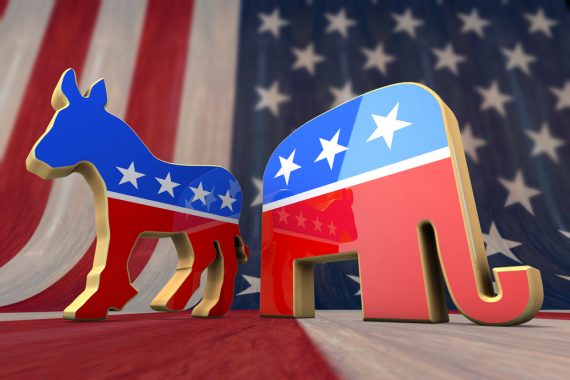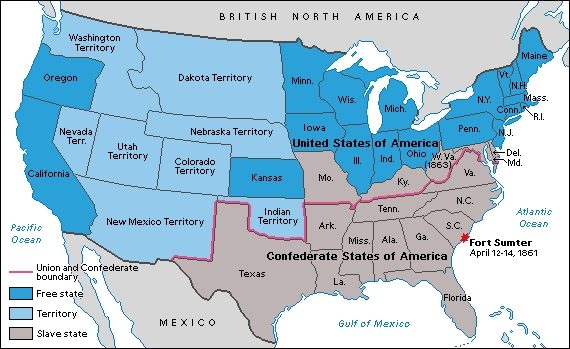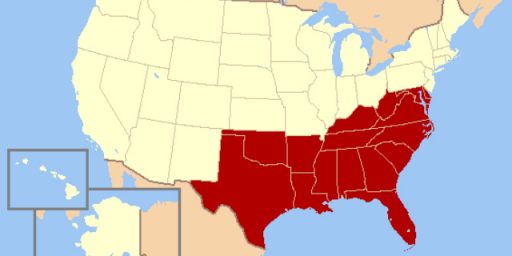More on the Evolution of US Party Politics
Specifically: the former confederacy and Democratic dominance.

The US party system has gone through a significant evolution that started over a quarter-century ago (the 1994 mid-terms being the key date, although it is not just about that election) that was pretty well complete by ~2010.
The key result of that evolution has been the sorting of the parties into more purely “liberal” and “conservative” parties. I use the scare quotes because the terms themselves are complicated and contested. But it is safe to say the following, prior to 1994 the two parties were not anywhere near as neatly sorted ideologically as they were starting in 1995, and especially by ~2010.
While we have long had the general perception of the Democrats as the liberal/left party and the Republicans as the conservative/right party there was a time wherein the concept of a “conservative Democrat” meant more than a simplistic description of Joe Manchin and the term “liberal Republican” would have represented a real, not hypothetical, thing.
It is worth noting that while we have seen some very significant and measurable shifts in partisan voting that those shifts have remain contained in the two parties that have dominated US electoral politics since the mid-19th Century. It did not result in new party formation. We have kept the contours of the party system even as the parties themselves have been reshaped. Of course, I think that that is largely a result of our system of nomination (and other institutional factors that I frequently discuss).
A major part of this shift is about the political behavior of parties in the south (defined in this post as the 11 CSA states).

I would argue that the politics of the Civil War and the Reconstruction period forestalled the sorting of the parties into well-defined ideological groupings. Indeed, it delayed that sorting for roughly a century. This was the result of one region of the country, the former Confederate South, functioning as essentially a one-party enclave. This distorted overall national party politics as a result.
So, what is the point of this post? Partially this is just about amassing some basic data (I did so, at least in part, to confirm my own general recollection/understanding of these patterns). It also points to the fact that understanding party behavior and evolution is not a simplistic Manichean exercise (as anyone who has witnessed the Kevin Kruse-Dinesh D’Souza Twitter dialogs can attest)
Below are further data to bolster this point. I have looked at the former states of the Confederacy (Alabama, Arkansas, Florida, Georgia, Louisiana, Mississippi, North Carolina, South Carolina, Tennessee, Texas, and Virginia) to note some very clear historical patterns as they pertain to party competition.
There are a lot of takeaways here, but let me note two. First, it is really rather remarkable to see how the politics of the Civil War and Reconstruction shaped national party politics for over a century after formal hostilities stopped. Second, voter behavior at the national and state level was less connected until fairly recently.
I have assembled basic historical data from these 11 states looking at overall patterns at the state level (governorships and partisan control of state legislatures) and at the national level (US Senate and the presidency).
Note the date 1872 (and thereabouts) in the tables and further note that Reconstruction came to an end in 1877 due to the Compromise of 1877. These dates have actually been in the news lately, as Senator Ted Cruz of Texas wanted to use the dispute over the 1876 election as a template for a commission to look at 2020’s vote. Of course, the 1876 election was marred by political violence in the south against Blacks in particular. The Compromise of 1877 led to the re-assertion of the power of the white supremacist wing of the Democratic Party and to Republicans being anathema in the region for a long time to come.
The rest of this post is mostly just the presentation of the relevant descriptive data. From the state/local level there are data on governors and control of state legislatures. From there I have info on US Senators and presidential elections.
Noteworthy elements:
- The shift to Republican dominance in the South is not immediate or uniform (but follows discernable, albeit imperfectly correlated patterns regionally by office).
- It starts with presidential elections (which makes sense–if the South is more conservative and the national conservative party was the GOP, then what choice did they have?). Even so, it takes a while.
- It takes almost a century (give or take, depending on the state) for statewide election (governor and Senator) to be two-party competitive.
- The trickle-down to local elections (state legislative districts) take over 100 years. The GOP does not fully filter down to the local level in the region into well into the Twenty-First Century. (And no state had a GOP trifecta before the year 2000).
Governors and State Legislatures
The regional dominance of the Democratic Party is well illustrated by the following table. Trifecta means control of the governorship and both chambers of the legislature.

First, even though there are some stragglers into the later 1800s, there is a striking consistency as to when it became impossible for a Republican to be elected to the statewide executive.
On balance, most states had Democratic governors for almost a century.
Tennessee has the 1911 election as an outlier, but it then reverted back to the Democratic fold not long thereafter, with only Dems in the governor’s mansion from 1923-1971.
In regards to the state legislature, it is noteworthy that the earliest case of Reps controlling the state legislature in a former CSA state was Florida in 1997. The rest took until the 2000s, most not until the second decade of the 21st Century.
It took all 11 former CSA states until the 2000s to win the governing trifecta.
This is just an illustration of how deeply the politics of the post-Civil War profoundly effected the US party system.
I would underscore that these shifts are the latest of the three areas under discussion here.
US Senate
If we shift the national offices, we can look to the election of US Senators (keeping in mind that US Senators were selected by legislatures until 1914).

The cracks in the solid Democratic South start in the 1960s (we saw above that a couple of southern states elected Republican governors in the late 60s).
Texas elects its first GOP Senator in John Tower via special election in 1961 to replace LBJ, who had been elected Vice President.
Strom Thurmond changed parties after disputes with the Democratic Party over civil rights legislation.
The majority of the former CSA states had at least one GOP Senator by the late 1970s, which tracks with the advent of Republican governors. But the penetration of these party identities down to the district level took well into the 2000s.
The Presidency
From 1952 until 1972 the region was more a mixed bag, and then it becomes pretty solidly Republican-leaning for president.
The presidency is where the first ability of southerners to vote Republican starts. While there is the case of TN voting for Harding in 1920, the former CSA states were solidly Dem form 1884 to 1924 and from 1932-1948.
Here’s a run-down:
- 1884-1918: Solidly Dem
- 1920: TN went Rep
- 1924: Solidly Dem
- 1928: FL, NC, TN, TX, and VA voted for Hoover (R)
- 1932-1948: Solid Dem
- 1952 and 1956: FL, TN, TX, and VA all liked Ike (R)
- 1960: Various weirdness
- 1964: Al, GA, LA, MS, and SC vote for Goldwater
- 1968: More weirdness
- 1972: First time the former CSA states vote 100% Rep.
- 1976: VA goes Rep
- 1980: Only GA stays Dem
- 1984-1988: Solid Rep
- 1992: AR, GA, LA, TN vote Dem
- 1996: AR, FL, LA, TN vote Dem
- 2000-2004: Solid Rep
- 2008: Fl, NC, VA go Dem
- 2012: FL, VA go Dem
- 2016: VA goes Dem
- 2020: GA, VA go Dem
This post fits into themes from the following previous posts:
Sources: Ballotpedia, Wikipedia (which is actually pretty good for this kind of thing), and Dave Leip’s Atlas of Presidential Elections.






Interesting Steven. I don’t have any great thoughts but it gives context. Thanx.
Ditto Ozark. I appreciate the context. Yes, the weirdness was certainly weird. What can I say about the 60’s, except to note that you really had to be there.
I’ve tended to think that we have three major groupings in the US — authoritarian big business enthusiasts, pro-democracy safety-net enthusiasts, and bigots. And there three groups drift between the parties (with some very significant inertia) — the bigots often being the deciding vote that allows major social change, but no one would be crazy enough to put them in charge at the national level.
The New Deal was possible because the safety-net enthusiasts and the bigots were all Democrats. Compromises were made to try to make sure that benefits didn’t get to those people, but this coalition got us Social Security, Medicare, and strong unions (people forget how racist unions were back in the day)
And now, the bigots are in charge of the Republican Party, and the big-business enthusiasts haven’t quite walked away, because they love them some tax breaks. The Protocols of the Elders of Zion have been updated for the Information Age to include Jewish Space Lasers and a Globalist Pedophile Ring run by Soros, Rothchilds and other Jews.
It always comes down to bigotry in this country — the original sin of slavery, with the added spice of anti-semitism haunting us to this day, because we refuse to acknowledge the effects is still has a hundred and fifty years after the civil war. I mean, it’s either that or we founded the country on an ancient Indian burial ground…
I have always thought that NC would follow VA as a democratic state but it looks as if Georgia is ahead of that transformation. I would like someone to explain Florida. Rubio a phony, Scott a crook and Desantis a trumpian acolyte.
@Raoul:
Two words: Cunningham’s weiner.
@Raoul:
Georgia beat NC to blue status due to the film business. NC cut off their film incentive about 8 years ago, or cut it back to the extent that major show stopped shooting there. Do not underestimate how much the film and TV businss coming to GA has impacted the state’s politics.
But NC will get there just due to it’s strong Tech sector in the Research Triangle. It’s coming. Meanwhile, Ohio and Iowa will probably become more GOP.
@Raoul:
Georgia may be extra blue this year, due to the pandemic, Trump, and the Senate runoffs having control of the senate in the balance.
Aside from Stacy Abrams’ group’s hard work, all sorts of unions put a lot of resources into the runoffs, and Trump was telling his base that their votes didn’t matter because of fraud, fraud, fraud. And it was close.
Georgia likely looks a lot bluer than it is.
@flat earth luddite:
Word.
@Raoul:
North Carolina: “As of the 2015 vintage year of the U.S. Census series starting in 2010, the U.S. Census estimated that the racial distribution of North Carolina’s population was 71.2% White American, 22.1% African American, 1.6% American Indian, 2.8% Asian, and 9.1% Hispanic or Latino (of any race).”
Georgia: “According to 2019 US Census Bureau estimates, Georgia’s population was 57.8% White (51.8% Non-Hispanic White and 5.9% Hispanic White), 31.9% Black or African American, 4.1% Asian, 3.0% Some Other Race, 0.4% Native American and Alaskan Native, 0.1% Pacific Islander and 2.7% from two or more races.”
@EddieInCA: Interesting connection that hadn’t occurred to me. I didn’t realize how deep the film industry penetrated Georgia. I will say, it seems like the actors and actresses for movies shot there aren’t as good looking as the ones that shoot in Cali. Maybe its just me.
@EddieInCA: \
If I’m not mistaken, NC’s HB2 compounded the issue, further driving away film (and other creative) industries so that they could punch some Trans people.
Excellent weekend posts Steven.
One thing I find interesting in all this is how change seems to be speeding up. The Democrats were in control of the South for a couple of generations. Then there was a period where control transitioned to Republicans. And now, less than a decade later in some cases, we appear to be seeing a transition back toward Democrats in some places. Is this a period of “weirdness” or something that will be more enduring? Rhetorical question because I really don’t know.
@Andy:
A couple?!
@Andy: I was perhaps too glib about the “weirdness” in 1960 and 1968. It had to do with Dixiecrats/unpledged delegates/George Wallace and deep south states being very upset about civil rights legislation.
@Andy:
While it is true that VA is basically blue, Georgia and NC perhaps purple, and Florida a swing state, I am not sure I would agree with this assessment.
For example, 8 of the 11 cases once the Rs won a trifecta, they held it (and for a decade or more except AR which is the most recent).
These things take time. I think there’s a real possibility that the entire coastal South is gradually getting bluer (yes, even SC–though that’s the hardest to defend) and may in the coming years all begin to resemble VA now. You could say I’m engaging in wishful thinking, but then people said the same thing before 2020 when Dems talked about turning GA blue. There’s a great deal of bad analysis out there that acts completely blind to political shifts until the moment the other party actually wins a state–getting closer than usual doesn’t count (thus Hillary’s 5-point loss in Georgia and 3.5-point loss in AZ were completely irrelevant and proved absolutely nothing, but when Biden won those states in the next cycle people were like, how the hell did that happen?!).
@Steven L. Taylor:
I suppose history will eventually show if the Trump effect will be another “weirdness” in the pattern or something else.
I guess we’ll see. I honestly don’t know, but demographics are shifting south and west, which I think has the potential for more significant changes.
@Andy: Perhaps to step back and point out that the phenomenon that I am describing here is not so much the question of whether a state is red, blue, or purple for presidential elections, but rather the main point is that during the century-plus without Rs in power at the state level was a period wherein there was essentially one-party rule and all significant electoral competition was contained within the Democratic Party.
Most of these states only became two-party competitive in the last couple of decades, and at that time the GOP became the dominant party.
So even if a state like GA elects a Dem gov we are talking about a fundamentally different partisan environment in terms of electoral competition than was the case not that long ago.
And, certainly, none of this predicts the future (although it certainly is quite suggestive of basic outcomes for the foreseeable future).